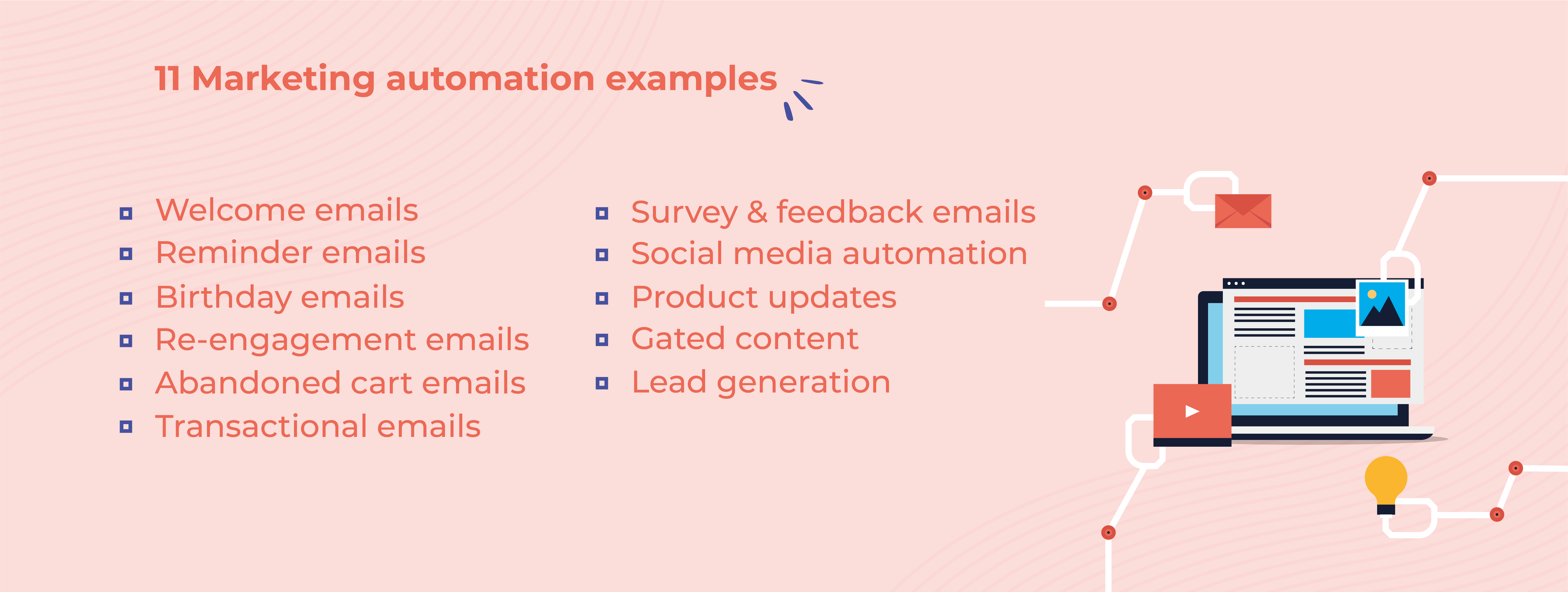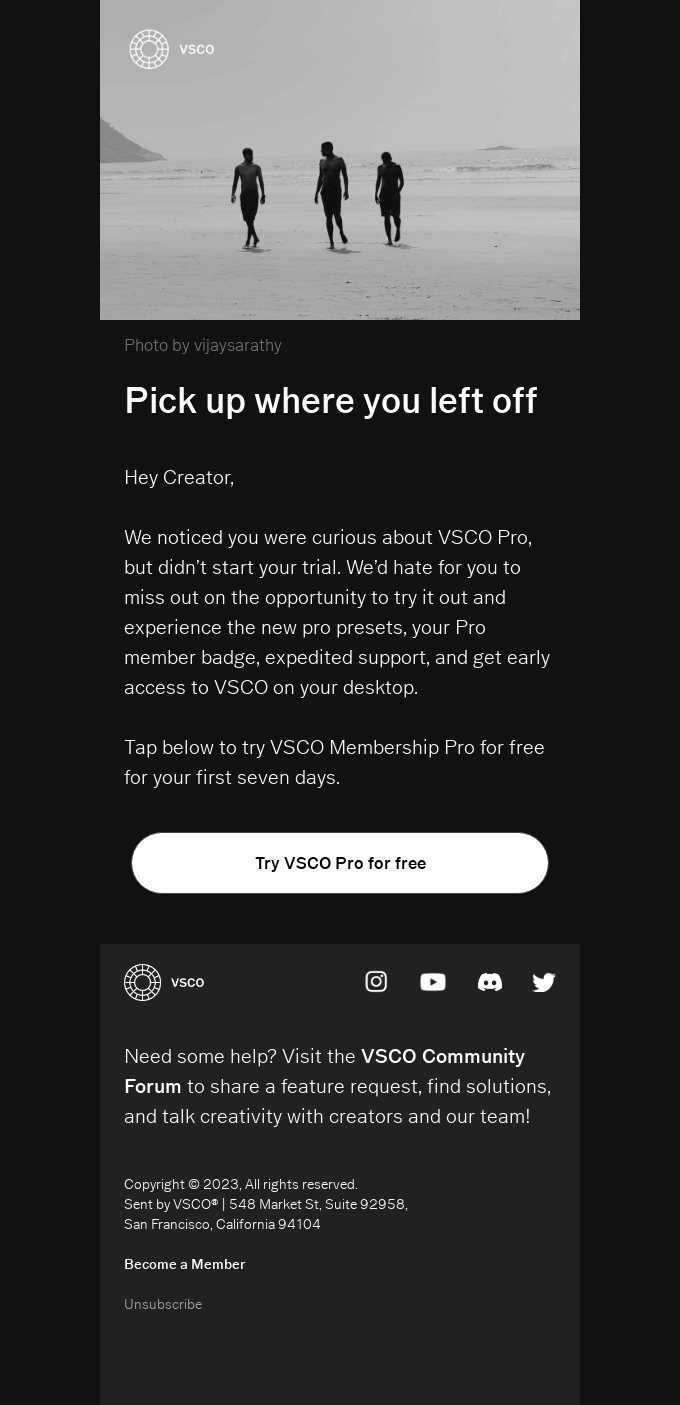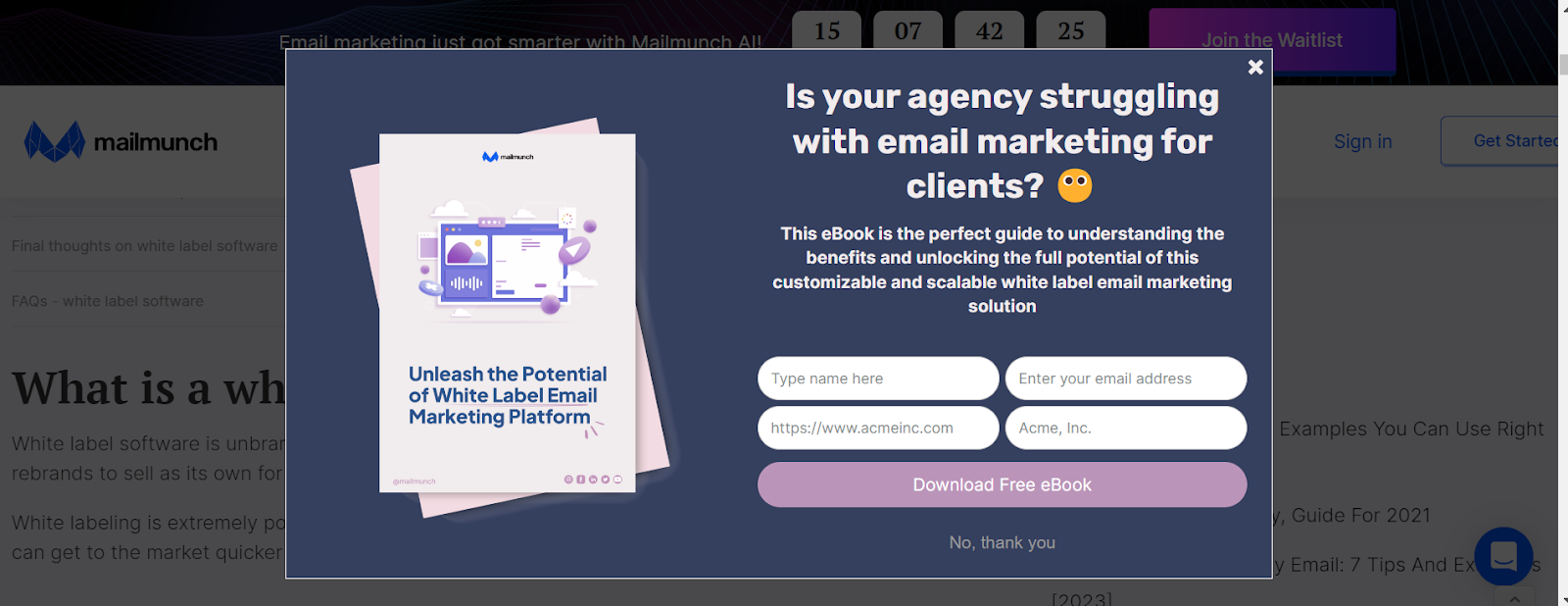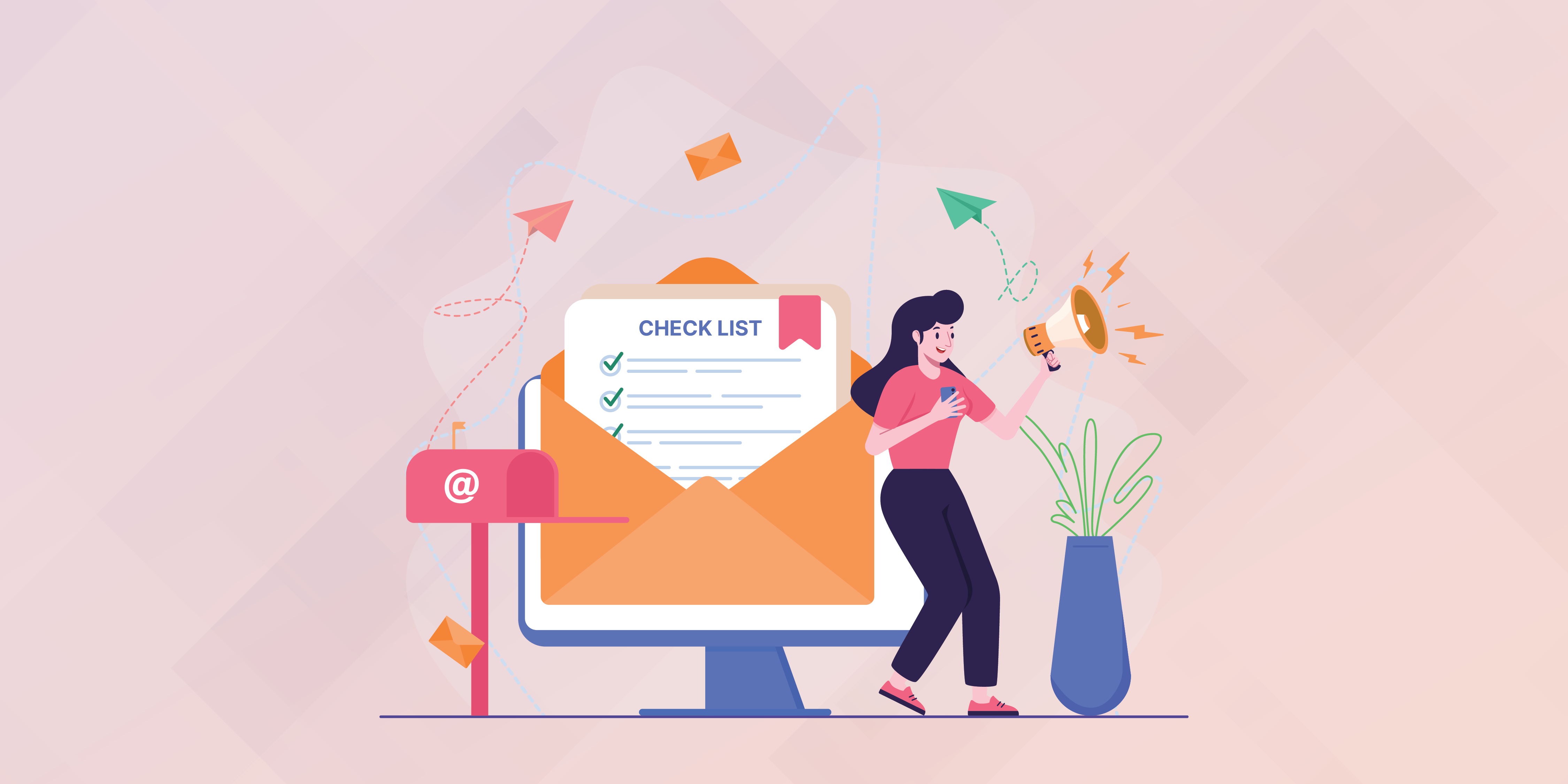.png)

Last updated on
January 22, 2024
Marketing automation has emerged as a game-changer, revolutionizing how businesses engage with their audience, generate leads, and nurture customer relationships. With its powerful tools and techniques, it has become an indispensable asset for companies looking to optimize their marketing efforts.
Today, we delve deeper into it and will explore eleven compelling marketing automation examples showcasing its versatility and impact on businesses. From crafting engaging welcome emails to re-engage dormant customers and leveraging gated content to automating transactional emails, it provides an arsenal of tools to transform your marketing strategy.
Marketing automation uses software tools and technologies to automate and streamline marketing activities. It involves utilizing digital platforms and systems to manage, track, and optimize various marketing processes, such as lead generation, nurturing, customer segmentation, email marketing, campaign management, and data analysis.
Today, the marketing automation buzzword is thrown around with a strong emphasis by start-up CEOs and multinational corporation executives. But why exactly are they doing it? Is marketing automation that important that 58% of B2B enterprises in the USA are willing to implement it in 2024?
Well, you can find it out for yourselves by looking at these 8 marketing automation benefits and some marketing automation examples later.
.png)
Automation reduces manual and repetitive tasks, saving time and effort for marketers. It enables streamlined workflows, allowing teams to focus on high-value activities like strategy development, content creation, and campaign optimization.
Moreover, 80% of marketers saw increased leads after using marketing automation software. automation thus helps capture and qualify leads more effectively. It enables personalized and timely communication with prospects, automates lead nurturing processes, and delivers relevant content based on their preferences and behaviors. This leads to higher conversion rates and improved customer acquisition.
Automation platforms provide tools for segmenting customer data, creating buyer personas, and delivering personalized content. Businesses can enhance engagement, build stronger relationships, and drive customer loyalty by tailoring marketing messages to specific customer segments or individual preferences.
Marketing automation allows businesses to manage and coordinate marketing efforts across various channels, including email, social media, websites, and mobile. It ensures consistent messaging and branding, maximizes reach, and enables businesses to engage with customers through their preferred channels.
Automation platforms provide comprehensive analytics and reporting features, offering valuable insights into campaign performance, customer behavior, and ROI. Marketers can track key metrics, measure the effectiveness of marketing initiatives, and make data-driven decisions to optimize strategies and improve results.
Integration with CRM systems facilitates seamless data sharing between marketing and sales teams. It improves lead management, enables better lead scoring and qualification, and enhances the alignment of sales and marketing efforts. This collaboration helps drive revenue growth and improves the overall customer experience.
According to Quixy, businesses that implemented marketing automation saw an increase of 77% in conversions.
Marketing automation supports scalability by enabling businesses to handle larger volumes of leads and customers without overwhelming manual efforts. It allows companies to scale their marketing activities efficiently and adapt to changing market dynamics as they grow.
Businesses can optimize resource allocation, reduce costs, and improve return on investment (ROI) by automating marketing processes. Automation helps eliminate wasteful spending on ineffective campaigns and allows marketers to allocate resources to high-performing activities that generate the best results.
Marketing automation is vital to make the most of your marketing strategy. But you are new to implementing marketing automation and need help understanding how to proceed. In that case, we have 11 marketing automation examples that can help you create the most effective marketing strategies and get the most out of them.

The first email to be sent when onboarding a new customer is the welcome email, which is the first marketing automation example. Welcome emails have a 50% open rate. That means over 75% of recipients are more likely to open welcome emails than other marketing emails.
Going by this logic, welcome emails should be the first email your newly acquired customer should get.
The purpose of a welcome email is to thank and acknowledge the customer's interest in your business. Also, you can use welcome emails to verify the recipient's email address. This will ensure that your recipient is genuine and keeps your email list healthy.
Depending on the information that you have, you can either personalize the email or can send a generic welcome email. You can add an onboarding checklist or share product tips for your customers to get themselves acclimatized with your product, just like in this welcome email from Slack.

However, you can offer discounts on first-time purchases if you have an eCommerce store. Moreover, you can espouse the benefits of your products and upsell them by offering complimentary products.

If your recipient doesn’t engage with your welcome email, it doesn’t mean they don’t want to. Life can happen to us all. It might happen that recipient saw your welcome email, got excited, but then thought to open it once they got home but forgot about it while stuck in 6 PM rush hour traffic.
Anything can happen. Therefore, you need to remind your recipients to take action. And what better way to remind them than with a timely reminder email? You can use email automation to send a reminder email if the recipient fails to act.
Reminder emails are the most classic marketing automation example. They can help you stay top-of-mind of your recipients. Again, You can talk about the benefits of your products or services and highlight your unique selling points. Just like in this example from VSCO.

It has now become standard practice to wish your customers a happy birthday. It makes customers feel that the brand cares about them. Also, it’s an excellent way to build rapport and strengthen relationships.
But crafting an email would take considerable time and effort and divert attention away from more essential marketing activities. This is where marketing automation comes to the rescue.
Now you can quickly create top birthday emails for your customers and finish such repetitive tasks. Also, you can add a few birthday gifts, like a discount or a voucher, to show your appreciation for your customers.

The next marketing automation example is the abandoned cart email. Abandoned carts are the bane of every eCommerce store in existence. eCommerce stores lose a lot of revenue due to abandoned carts. Just to put things into perspective, 69% of shoppers abandon their carts. This means that sales numbers are only one-third of what they could have been!
This huge problem is causing eCommerce businesses to lose a lot of revenue. But through automated abandoned cart emails, marketers are trying to overcome this. By utilizing urgency and scarcity tactics, you can regain your lost revenue.
You can set deadlines for customers to take action. Because if customers wait for a long time to take make a purchase, then it is more likely that they will not make it. Also, you can offer discounts on the products in the cart to sweeten the pot, just like in this email from Fabletics Men.

No one likes seeing customers go, and no company boasts about 100% customer loyalty. Nonetheless, you can increase customer retention rates by automating re-engagement emails. Another marketing automation example is re-engagement emails. By leveraging email automation software, you can ensure that you send personalized content to your churned customers just at the right time for them to return.
Here’s an example from Headspace that can illustrate the point.

Survey and feedback emails may be the most straightforward marketing automation example, but they can help resolve some critical issues with your business. As mentioned, marketing automation allows companies to get data-driven insights into their customers and business.
Businesses can learn about customer pain points by automating feedback emails and quickly resolving them before the customer churns. Moreover, companies can understand changing tastes and trends and tailor their messaging and product placement accordingly.

Another marketing automation example is social media automation. Social media management is another task that can benefit from being automated. Marketing teams can do more by automating repetitive tasks. Not only will it help prioritize tasks better, but it will also be beneficial in managing workloads. With social media automation, businesses can:
Product updates are also a great marketing automation example. Companies always need to share product updates with their customers. They can send automated product update emails to notify customers about recent changes and additions. Moreover, you can personalize the email for product features unavailable in specific locations.

Gated content is another excellent marketing automation example. Marketing automation tools can automate the process of delivering gated content, such as eBooks, whitepapers, or webinars. When a visitor fills out a form to access the content, their information is captured, and they can be added to an automated email nurturing campaign to further engage and nurture them as a lead.
Here’s an example of Mailmunch’s gated content offer.

One of the most profound marketing automation examples is lead generation. Marketing automation platforms help streamline lead generation efforts. They can automatically capture and store lead information from various sources, such as website forms, landing pages, or social media.
Once captured, leads can be segmented based on their interests or demographics, and automated nurturing campaigns can be triggered to deliver personalized content and move them through the sales funnel.
Marketing automation is commonly used to send transactional emails, such as order confirmations, shipping notifications, or account updates. These emails can be automated and sent immediately after a specific action or event occurs, ensuring timely and relevant customer communication.
Marketing automation has become a driving force behind successful marketing strategies, revolutionizing how businesses connect with their audience, generate leads, and nurture customer relationships. The diverse range of marketing automation examples discussed above demonstrates the breadth and depth of its capabilities.
Whether streamlining lead generation and nurturing, delivering personalized and timely communication, or leveraging data-driven insights to optimize campaigns, marketing automation offers immense potential for businesses seeking to enhance their marketing efforts and achieve tangible results.
If you're ready to unlock the power of marketing automation, platforms like Mailmunch can be your trusted partner on this transformative journey. By automating your marketing efforts, you can save time, increase efficiency, and drive better outcomes for your business.
So why wait? Embrace marketing automation, empower your marketing strategy, and unlock a world of possibilities for your marketing success with Mailmunch!
A voracious reader and a music lover, Ammar has been writing engaging and informative content for over 3 years for B2B and B2C markets. With a knack for writing SEO-optimized content, Ammar ensures the results speak for themselves.
Tags:

M. Usama
April 19, 2024

M. Usama
April 19, 2024

M. Usama
April 18, 2024